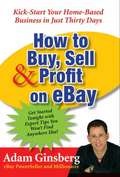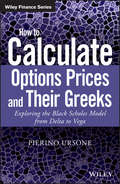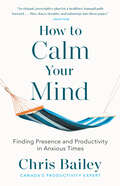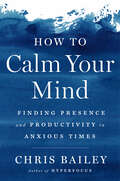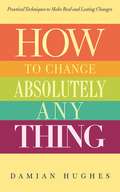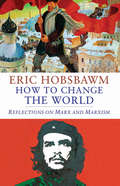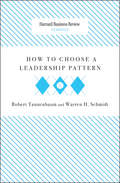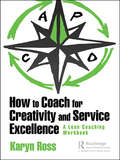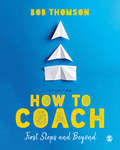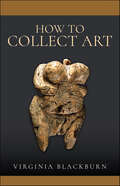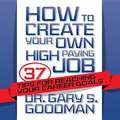- Table View
- List View
How to Buy and Sell a Business: How You Can Win in the Business Quadrant
by Garrett SuttonSutton, who is a corporate attorney, identifies the pitfalls and obstacles to avoid when buying and selling a business, and emphasizes the importance of putting together a team of professional advisors for help along the way. He discusses confidentiality, franchises, the elements of a selling prospectus, reading financial reports, valuations methods, negotiations to structure the deal, and tax considerations. No index is provided. Annotation ©2004 Book News, Inc., Portland, OR (booknews.com)
How to Buy, Sell, and Profit on eBay
by Adam GinsbergA lively insider's guide to starting a successful small business selling items old and new on eBay, written with personal anecdotes, well-kept secrets, and insider tips by Adam Ginsberg, eBay's most successful private salesperson. This is the insider's guide to making money on eBay. Adam Ginsberg is the most successful seller on eBay, moving around a million dollars' worth of merchandise every month. Not only will he impart his personal secrets on how to sell on eBay -learned through years of experience - and his tips on expanding your small business using eBay as a global market, but he'll also give fun side-notes and anecdotes, keeping the book lively and making it a fun and interesting read. This book will be a must-have for all current and aspiring eBay sellers, all small-business owners, and anyone who wants to learn how to start a million-dollar company.
How to Calculate Options Prices and Their Greeks
by Pierino UrsoneA unique, in-depth guide to options pricing and valuing their greeks, along with a four dimensional approach towards the impact of changing market circumstances on options How to Calculate Options Prices and Their Greeks is the only book of its kind, showing you how to value options and the greeks according to the Black Scholes model but also how to do this without consulting a model. You'll build a solid understanding of options and hedging strategies as you explore the concepts of probability, volatility, and put call parity, then move into more advanced topics in combination with a four-dimensional approach of the change of the P&L of an option portfolio in relation to strike, underlying, volatility, and time to maturity. This informative guide fully explains the distribution of first and second order Greeks along the whole range wherein an option has optionality, and delves into trading strategies, including spreads, straddles, strangles, butterflies, kurtosis, vega-convexity , and more. Charts and tables illustrate how specific positions in a Greek evolve in relation to its parameters, and digital ancillaries allow you to see 3D representations using your own parameters and volumes. The Black and Scholes model is the most widely used option model, appreciated for its simplicity and ability to generate a fair value for options pricing in all kinds of markets. This book shows you the ins and outs of the model, giving you the practical understanding you need for setting up and managing an option strategy. * Understand the Greeks, and how they make or break a strategy * See how the Greeks change with time, volatility, and underlying * Explore various trading strategies * Implement options positions, and more Representations of option payoffs are too often based on a simple two-dimensional approach consisting of P&L versus underlying at expiry. This is misleading, as the Greeks can make a world of difference over the lifetime of a strategy. How to Calculate Options Prices and Their Greeks is a comprehensive, in-depth guide to a thorough and more effective understanding of options, their Greeks, and (hedging) option strategies.
How to Calm Your Mind: Finding Presence and Productivity in Anxious Times
by Chris BaileyA toolkit of accessible, science-backed strategies that reveal that the path to a less anxious life, and even greater productivity, runs directly through calm.When Chris Bailey, productivity expert, discovered that he had become stressed and burnt out because he was pushing himself too hard, he realized that he had no right to be giving advice on productivity without learning when and how to rein things in and take a break. Productivity advice works—and we need it now more than ever—but it&’s just as important that we also develop our capacity for calm. By finding calm and overcoming anxiety, we don&’t just feel more comfortable in our own skin, we invest in the missing piece that leads our efforts to become sustainable over time. We build a deeper, more expansive reservoir of energy to draw from throughout the day, and have greater mental resources at our disposal to not only do good work, but to also live a good life.Among the topics How to Calm Your Mind covers are how analog and digital worlds affect calm and anxiety in different ways; how our desire for dopamine, a neurotransmitter in our brain that leads us to feel overstimulated, breeds anxiety, dissatisfaction, and needless stress, but can be countered by other neurochemicals; how hidden sources of stress can be tamed by a &“stimulation fast&”; and how &“busyness&” is as much a state of mind as it is an actual state of life. The pursuit of calm ultimately leads us to become more engaged, focused, and deliberate—while making us more productive and satisfied with our lives overall. In an anxious world, achieving calm is the best life hack around.
How to Calm Your Mind: Finding Presence and Productivity in Anxious Times
by Chris BaileyA toolkit of accessible, science-backed strategies that reveal how the path to a less anxious life, and even greater productivity, runs directly through calm. A PENGUIN LIFE BOOKWhen productivity expert Chris Bailey discovered that he had become stressed and burnt out because he was pushing himself too hard, he realized that before he could continue to give advice on productivity, he needed to learn how to rein things in and take a break. Productivity advice works—and we need it now more than ever—but it&’s just as vital that we also develop our capacity for calm. By finding calm and overcoming anxiety, we don&’t just feel more relaxed and at ease—we invest in the missing piece that leads our efforts to become sustainable over time. We build a deeper, more expansive reservoir of energy to draw from throughout the day, and have greater mental resources at our disposal to do good work and live a meaningful life.Among the topics How to Calm Your Mind covers are:How analog and digital worlds affect calm and anxiety in different waysHow our desire for the neurochemical dopamine can lead us to feel anxious and appreciate everyday experiences lessHow hidden sources of stress can be tamed by a &“stimulation fast&”How we can use the science of &“savoring&” to become present and enjoy life moreHow &“busyness&” is as much a state of mind as it is an actual state of lifeThe pursuit of calm ultimately leads us to become more engaged, focused, and deliberate—while making us more productive and satisfied with our lives. In an anxious world, investing in calm can be considered the best productivity strategy around.
How to Calm Your Mind: Finding Presence and Productivity in Anxious Times
by Chris BaileyA toolkit of accessible, science-backed strategies that reveal that the path to a less anxious life, and even greater productivity, runs directly through calm.When Chris Bailey, productivity expert, discovered that he had become stressed and burnt out because he was pushing himself too hard, he realized that he had no right to be giving advice on productivity without learning when and how to rein things in and take a break. Productivity advice works—and we need it now more than ever—but it&’s just as important that we also develop our capacity for calm. By finding calm and overcoming anxiety, we don&’t just feel more comfortable in our own skin, we invest in the missing piece that leads our efforts to become sustainable over time. We build a deeper, more expansive reservoir of energy to draw from throughout the day, and have greater mental resources at our disposal to not only do good work, but to also live a good life.Among the topics How to Calm Your Mind covers are how analog and digital worlds affect calm and anxiety in different ways; how our desire for dopamine, a neurotransmitter in our brain that leads us to feel overstimulated, breeds anxiety, dissatisfaction, and needless stress, but can be countered by other neurochemicals; how hidden sources of stress can be tamed by a &“stimulation fast&”; and how &“busyness&” is as much a state of mind as it is an actual state of life. The pursuit of calm ultimately leads us to become more engaged, focused, and deliberate—while making us more productive and satisfied with our lives overall. In an anxious world, achieving calm is the best life hack around.
How to Capture the Explosion: MacGyver and Boiling Potatoes--Making Intersectional Ideas Happen
by Frans JohanssonThe most successful innovators are capable of breaking down associative barriers between seemingly unconnected fields to produce and realize a massive number of potentially groundbreaking ideas. The trick is learning to capture the best opportunities and make them happen.
How to Castrate a Bull
by Pat Walsh Dave HitzDave Hitz likes to solve fun problems. He didn't set out to be a Silicon Valley icon, a business visionary, or even a billionaire. But he became all three. It turns out that business is a mosaic of interesting puzzles like managing risk, developing and reversing strategies, and looking into the future by deconstructing the past.As a founder of NetApp, a data storage firm that began as an idea scribbled on a placemat and now takes in $4 billion a year, Hitz has seen his company go through every major cycle in business--from the Jack-of-All-Trades mentality of a start-up, through the tumultuous period of the IPO and the dot-com bust, and finally to a mature enterprise company. NetApp is one of the fastest-growing computer companies ever, and for six years in a row it has been on Fortune magazine's list of Best Companies to Work For. Not bad for a high school dropout who began his business career selling his blood for money and typing the names of diseases onto index cards.With colorful examples and anecdotes, How to Castrate a Bull is a story for everyone interested in understanding business, the reasons why companies succeed and fail, and how powerful lessons often come from strange and unexpected places.Dave Hitz co-founded NetApp in 1992 with James Lau and Michael Malcolm. He served as a programmer, marketing evangelist, technical architect, and vice president of engineering. Presently, he is responsible for future strategy and direction for the company. Before his career in Silicon Valley, Dave worked as a cowboy, where he got valuable management experience by herding, branding, and castrating cattle.
How to Change Absolutely Anything: Practical Techniques to Make Real and Lasting Changes
by Damian Hughes Bill PigginsEveryone wants to change something about their life. These changes can be as simple as finding a way to eliminate some of life’s little annoyances from the day-to-day or as profound as finally taking action towards achieving a lifelong ambition. Regardless of where you fall on this spectrum, if you’re serious about changing your life, you need to answer these fundamental questions: What change do you want to make? How are you going to do it?In this book you will learn all you need to make real and lasting changes to just about anything in your life—no matter the problem and no matter your goal. Uncover life-changing secrets, mindsets, and practical techniques, such as: Making first impressions Crafting how others perceive you The power of emotions Controlling your feelings Reacting to change Being flexible Promoting change through your core beliefs Avoiding mistakes that impede positive change Understanding influences Taking actionYou can read it cover to cover or just peruse its wealth of tips and tricks if ever you’re facing a challenge and need some sharp advice or keen inspiration to spur change forward. Whichever approach you take, you’ll feel empowered, emboldened, energized, and ready to steamroll any obstacles, overcome even the harshest objections, and learn how to affect change in whatever you set your mind to.
How to Change Minds: The Art of Influence without Manipulation
by Rob JollesPersuade, Don’t Push! Surely you know plenty of people who need to make a change, but despite your most well-intentioned efforts, they resist because people fundamentally fear change. As a salesman, father, friend, and consultant, Rob Jolles knows this scenario all too well. Drawing on his highly successful sales background and decades of research, he lays out a simple, repeatable, predictable, and ethical process that will enable you to lead others to discover for themselves what and why they need to change. Whether you hope to make a sale or improve a relationship, Jolles’s wise advice—illustrated through a bevy of sometimes funny, sometimes moving, always illuminating stories—will help you ensure that changing someone’s mind is never an act of coercion but rather one of caring and compassion.
How to Change the World: Tales of Marx and Marxism
by Eric HobsbawmIn the 144 years since Karl Marx's Das Kapital was published, the doctrine that bears his name has been embraced by millions in the name of equality, and just as dramatically has fallen from grace with the retreat of communism from the western world. But as the free market reaches its extreme limits in the economic and environmental fallout, a reassessment of capitalism's most vigorous and eloquent enemy has never been more timely. Eric Hobsbawm provides a fascinating and insightful overview of Marxism. He investigates its influences and analyses the spectacular reversal of Marxism's fortunes over the past thirty years.
How to Change: The Science of Getting from Where You Are to Where You Want to Be
by Katy MilkmanAward-winning Wharton Professor and Choiceology podcast host Katy Milkman has devoted her career to the study of behavior change. In this ground-breaking book, Milkman reveals a proven path that can take you from where you are to where you want to be, with a foreword from psychologist Angela Duckworth, the best-selling author of Grit.Set audacious goals. Foster good habits. Create social support. You've surely heard this advice before. If you've ever tried to change or encourage it -- to boost exercise or healthy eating, to prevent missed deadlines or kick-start savings -- then you know there are thousands of apps, books, and YouTube videos promising to help and offering sound guidance. And yet, you're still not where you want to be.This trailblazing book from award-winning behavioral scientist and Wharton Professor Katy Milkman explains why. In a career devoted to uncovering what helps people change, Milkman has discovered a crucial thing many of us get wrong: our strategy. Change, she's learned, comes most readily when you understand what's standing between you and success and tailor your solution to that roadblock. If you want to work out more but find exercise difficult and boring, downloading a goal-setting app probably won't help. But what if, instead, you transformed your workouts so they became a source of pleasure instead of a chore? Turning an uphill battle into a downhill one is the key to success.Drawing on Milkman's original research and the work of her dozens of world-renowned scientific collaborators, How to Change shares an innovative new approach that will help you change or encourage change in others. Through case studies, engaging stories, and examples from cutting-edge research, this book illustrates how to identify and overcome the barriers that regularly stand in the way of change. How to Change will teach you: • Why timing can be everything when it comes to making a change • How to turn temptation and inertia into assets that can help you conquer your goals • That giving advice, even if it's about something you're struggling with, can help you achieve moreWhether you're a manager, coach, or teacher aiming to help others change for the better or are struggling to kick-start change yourself, How to Change offers an invaluable, science-based blueprint for achieving your goals, once and for all.
How to Choose a Leadership Pattern (Harvard Business Review Classics)
by Warren H. Schmidt Robert TannenbaumSince 1922, Harvard Business Review has been a leading source of breakthrough management ideas-many of which still speak to and influence us today. The Harvard Business Review Classics series now offers readers the opportunity to make these seminal pieces a part of your permanent management library. Each highly readable volume contains a groundbreaking idea that continues to shape best practices and inspire countless managers around the world-and will have a direct impact on you today and for years to come.
How to Choose the Right Forecasting Technique
by Donald D. Smith Satinder K. Mullick John C. ChambersTwo Corning Glass Works products illustrate the use of various forecasting techniques. Managers and forecasters should consider three issues when approaching a forecasting problem: the purpose of the forecast, the dynamics and components of the system, and the importance of the past in estimating the future. The three basic forecasting methods are qualitative techniques, time series analysis and projection, and causal methods. A gatefold chart presents several examples of each type of technique, its feaures, and limitations. Although sales forecasting primarily has used forecasting techniques, these techniques will be applied increasingly to forecasting margins, capital expenditure, and other important factors.
How to Click with People
by Rick KirschnerThe Secret to Building Better Relationships in Business and in Life With some people, you just click. The connection is quick and easy. Communication flows. You can tell them anything and they know just what you mean. When you connect in this way, you feel understood and accepted for who you really are. You "get" these people and they get you. We think of this connection as an instantaneous thing, something that either happens or doesn't. Not so, says author Dr. Rick Kirschner. This connection isn't a magical phenomenon; it's a communication skill that can be learned with specific steps and techniques. Based on the author's three decades of experience as an interpersonal communication expert, How to Click with People will show you how to: -Recognize and respond effectively to the four basic communication styles everyone uses-Speak the same language as the person you're talking to, whether emotional or intellectual-Connect in a digital age ruled by e-mail and social media-Master the 7 Signals that will make you-and your ideas-click with others-Troubleshoot the nine obstacles that could be in your way and learn how to avoid or overcome themIn the end, Kirschner argues that these skills are crucial because success has less to do with professional knowledge than with "the ability to express ideas, to assume leadership, and to arouse enthusiasm among people." In this How to Win Friends and Influence People for the twenty-first century, he gives readers the advice and insights they need to strengthen their relationships and take charge of their future. people in your life. If you want to build better relationships, I recommend it."--Mark Sanborn, bestselling author of The Fred Factor"Wise people know that the future is all about people, and Rick Kirschner's new book How to Click with People is a must-read for anyone who wants to understand and use the transformative power of relationships both in business and in life."--Daniel Burrus, author of the New York Times bestseller Flash Foresight"In today's crazy-busy business environment, building strong relationships with frazzled customers and co-workers is essential to your success. Kirschner shows you practical strategies to quickly 'click' with even the most challenging individuals."--Jill Konrath, author of SNAP Selling and Selling to Big Companies
How to Coach for Creativity and Service Excellence: A Lean Coaching Workbook
by Karyn RossHow to Coach for Creativity and Service Excellence: A Lean Coaching Workbook is a self-contained workbook, in which the reader completes twenty-one days of practical exercises and activities focused on creativity, lean and coaching (one set per day). This will enable the reader to develop their capability and confidence to be creative, adapt lean principles, practices and tools to their unique service organization and coach others to do the same. The workbook guides the reader through a structured, systematic, easy-to-understand, habit-building approach, and function as the reader’s ‘coach’. As the reader ‘works’ their way through the book, they will reclaim their creativity, learn Karyn’s tried-and-true 15-minute a day coaching approach and adapt lean principles, practices and tools to their particular service organization. As an internationally acclaimed lean consultant, highly experienced coach and coauthor of The Toyota Way to Service Excellence, Karyn Ross is often asked to help service organizations that are struggling to translate lean principles into the sustainable practices that will meet their - and their customers' - unique needs, now and for the long-term. Over the years, Karyn has found that the best way for organizations to overcome this struggle is to develop a network of coaches who can help people at all levels: • Learn by ‘doing’. Changing what we do – and seeing the different result - changes how we think, not the opposite! • Adapt lean in a way that makes sense for their service organization. Lean practitioners working in service organizations may have difficulty adapting lean manufacturing practices to meet the special ‘people’ considerations found in services. • Practice continuously to make a habit. Coaching helps people develop the discipline and stamina needed to turn new behaviors into habits. That’s the beauty of this book! It functions as the reader’s personal ‘coach’, guiding them through the daily practice required to make new behaviors (and the resulting new thinking) a habit, so that they can coach their organization to success!
How to Coach: First Steps and Beyond
by Bob ThomsonHow to Coach: First Steps and Beyond is an essential guide for anyone starting out in the coaching profession and for existing coaches seeking to develop their craft. It is a practical introduction to the theory, skills and art of coaching. This extremely practical introduction contains numerous case studies showing theory in action, aiding in understanding of how to apply theory to actual practice in a variety of settings. The book: Uses clear, uncomplicated language throughout Explains key ideas through brief illustrations from the author′s practice and quotes from leading writers on coaching Contains a wide selection of ideas, models and exercises to stimulate the reader′s learning Encourages students to try things out in conversation, and reflect upon and make sense of their experiences How to Coach is a must-have book for anyone interested in coaching skillfully, ethically and effectively.
How to Coach: First Steps and Beyond
by Bob ThomsonHow to Coach: First Steps and Beyond is an essential guide for anyone starting out in the coaching profession and for existing coaches seeking to develop their craft. It is a practical introduction to the theory, skills and art of coaching. This extremely practical introduction contains numerous case studies showing theory in action, aiding in understanding of how to apply theory to actual practice in a variety of settings. The book: Uses clear, uncomplicated language throughout Explains key ideas through brief illustrations from the author′s practice and quotes from leading writers on coaching Contains a wide selection of ideas, models and exercises to stimulate the reader′s learning Encourages students to try things out in conversation, and reflect upon and make sense of their experiences How to Coach is a must-have book for anyone interested in coaching skillfully, ethically and effectively.
How to Collect Art
by Virginia BlackburnA comprehensive and up-to-date guide to collecting across the board, from grand Old Masters to humble kitchenalia. People have always made art and people have always collected art. But it is only recently that collecting became possible for everyone, not just the very rich. Indeed, collecting has never been more popular, as the rise of art fairs, antique fairs, television programs devoted to finding treasures in your attic and much more attests. And not only is collecting fun, it could be potentially very profitable, too. But where to start? These days everything is collectable, from Old Masters to 1950s kitchenalia and it can be bewildering when you start out. And not just when you start out. Even experienced collectors need some help and guidance and How To Collect Art provides exactly this. Author and collecting expert Virginia Blackburn takes you through everything you need to know, tackling not only mainstream fields such as paintings, furniture, china and statuary, but through antiquities, modern sculpture, Sailors’ Valentines, street art, and much more. This is a comprehensive look at many and varied fields of collecting, for amateur and professional alike. Virginia also explains how to educate yourself in your chosen field, and where to go to find the art you buy, covering galleries, auctions, degree shows and more. She explains how, when and where to bargain, looks at ways of displaying your collection and helps you get into the mindset of a collector. Art may be for art’s sake, but it provides the rest of us with a lot of pleasure too.
How to Communicate Successfully: The Halvorson Collection (2 Books)
by Heidi Grant HalvorsonCommunication in the workplace is more important than ever. This Harvard Business Review digital collection presents the work of social psychologist and bestselling author Heidi Grant Halvorson. In No One Understands You and What to Do About It, Halvorson explains why we're often misunderstood and how we can fix that. Most of us assume that other people see us as we see ourselves, and that they see us as we truly are. But neither is true. Our everyday interactions are colored by subtle biases that distort how others see us-and also shape our perceptions of them. You can learn to clarify the message you're sending once you understand the lenses that shape perception-trust, power, and ego-and how these lenses affect your interactions. In the short, powerful Nine Things Successful People Do Differently, the strategies and goals of the world's most successful people are on display-backed by research that shows exactly what has the biggest impact on performance. Here's a hint: accomplished people reach their goals because of what they do, not just who they are.
How to Complete a Risk Assessment in 5 Days or Less
by Thomas R. PeltierSuccessful security professionals have had to modify the process of responding to new threats in the high-profile, ultra-connected business environment. But just because a threat exists does not mean that your organization is at risk. This is what risk assessment is all about. How to Complete a Risk Assessment in 5 Days or Less demonstrates how to identify threats your company faces and then determine if those threats pose a real risk to the organization. To help you determine the best way to mitigate risk levels in any given situation, How to Complete a Risk Assessment in 5 Days or Less includes more than 350 pages of user-friendly checklists, forms, questionnaires, and sample assessments. Presents Case Studies and Examples of all Risk Management Components based on the seminars of information security expert Tom Peltier, this volume provides the processes that you can easily employ in your organization to assess risk. Answers such FAQs as: Why should a risk analysis be conducted Who should review the results? How is the success measured? Always conscious of the bottom line, Peltier discusses the cost-benefit of risk mitigation and looks at specific ways to manage costs. He supports his conclusions with numerous case studies and diagrams that show you how to apply risk management skills in your organization-and it's not limited to information security risk assessment. You can apply these techniques to any area of your business. This step-by-step guide to conducting risk assessments gives you the knowledgebase and the skill set you need to achieve a speedy and highly-effective risk analysis assessment in a matter of days.
How to Create Your Own High Paying Job: 37 Tips for Reaching Your Career Goals
by Gary S. GoodmanAre you unemployed? Or, are you overworked, underpaid, and stuck in a lifeless job, reporting to someone who doesn't seem to be doing much better than you are? You're not alone.Corporations once needed large inflows of middle managers and the formally educated. Many of these posts have disappeared or have been displaced by outsourcing, offshoring, international competition, and by technology.There is a widespread and growing under-employment problem facing almost every society. Many are working at jobs that do not require the experience and schooling they possess.In the United States up to 44% are under-employed; in Canada this number is 40%.Though there has been some job growth over the past few years, these jobs are mostly lower-paid without a solid ladder to success.In this original and groundbreaking book, you'll learn how to develop your own highly compensated career opportunities.Specifically, you'll learn new and exciting ways to:Identify your marketable skills and attributesTranslate your strengths into in-demand occupational titlesExpress your capabilities in results that are highly sought after by today's organizationsMarket yourself in several ways:As an employee, consultant, coach, vendor, and contract associateGet paid what you're worth, and far more through enhanced negotiation skillsDevelop new, highly paid occupational titles that put you into a class by yourselfLearn to overcome the hurdles and barriers of the traditional job marketUse advertised job listings as springboards to better jobsReach top executives presenting yourself and your capabilities at the highest possible levels, and more
How to Create Your Own Jewelry Line: Design – Production – Finance – Marketing & More
by Emilie ShapiroTo develop a successful jewelry line, designers have to be more than just creative artists—they have to understand the ins and outs of running a crafts business. Emilie Shapiro&’s detailed guide explores the many facets of creating a quality handmade collection that people will buy, including where to sell your work, how to do small-scale production, how to carry out market research and publicity, how to price and present your pieces for greatest effect, and so much more. It&’s the perfect primer for budding jewelry entrepreneurs.
How to Create a Coaching Culture
by Ro Gorell Gillian JonesHow to Create a Coaching Culture is a practical guide to developing an effective, efficient coaching culture in your organization. It demonstrates how to empower your workforce to achieve higher performance and greater business results. Specifically tailored to practitioner needs it offers an overview of coaching practice and aligns it clearly with organizational and HR strategy and objectives. Using a combination of practical tools, assessments, scenarios and case studies from best practice it will build your fundamental knowledge and equip you to take action by planning, pitching, and building a scheme. It also offers a complete framework for evaluating benefits and measuring return on investment.
How to Create a Coaching Culture: A Practical Introduction (HR Fundamentals #3)
by Ro Gorell Gillian JonesManagement approaches and workplace culture help determine employee productivity, morale, talent acquisition and retention, and organizational adaptability. How to Create a Coaching Culture is a practical guide to embedding effective coaching behaviours within an organization to empower and engage employees to perform at their best. Using a combination of practical tools, assessments, case studies and examples, it provides guidance on how to plan and develop a strategy aligned to your organization and its goals, engage the board to secure 'buy-in', and how to effectively measure and evaluate initiatives in every stage of the employee lifecycle.This fully updated second edition of How to Create a Coaching Culture contains new material on promoting employee engagement, reinventing performance reviews, and new and updated case studies from HarperCollins, British Airways and Leanintuit. Online resources include a series of downloadable templates and tools to use in practice, including a board report, communication strategy, development plan, and pre- and post-course training assessment.HR Fundamentals is a series of succinct, practical guides for students and those in the early stages of their HR careers. They are endorsed by the Chartered Institute of Personnel and Development (CIPD), the UK professional body for HR and people development, which has over 145,000 members worldwide.

